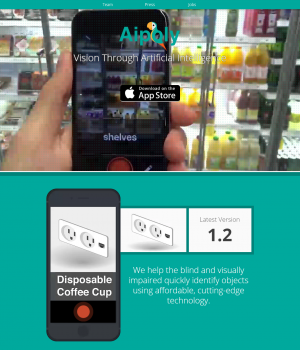This SMART 100 profile and the information it contains is a duplication of content submitted by the applicant during the entry process. As a function of entry, applicants were required to declare that all details are factually correct, do not infringe on another’s intellectual property and are not unlawful, threatening, defamatory, invasive of privacy, obscene, or otherwise objectionable. Some profiles have been edited for reasons of space and clarity.
Learn more about the SMART 100 >>
1. THE BEGINNING
This innovation initially came to life when…
We decided to use artificial intelligence (AI) to tackle blindness and visual impairment, which affects 285 million people worldwide and 225,000 in Australia. I’ve volunteered for guide dogs Australia for 7 years, and my co-founders have visually impaired friends to whom they describe their surroundings to paint a mental picture. While studying state-of-the-art AI, I realised in 2015 that computers were reaching human level intelligence when identifying objects, so myself and my two co-founders prototyped a system that would “see and speak” for the blind. We had 88 blind users test it and many reacted with excitement and strong emotions.
2. WHAT & HOW
The purpose of this innovation is to…
Aipoly is an AI that allows computers to see, understand, and talk. In January 2016 we launched Aipoly vision, an app that identifies 1,000 items in real-time without using the internet. Simply wave your phone and listen to the descriptions.
It does this by…
Warning! Technical jargon ahead. Aipoly uses convolutional neural networks, an innovative architecture of algorithms inspired by the animal visual cortex. The network was trained using powerful computers and shown over 10 million images to give it an idea of reality. Once trained, it’s a tiny 128Mb simulated brain. But the app is simple: Press a button, point your phone, listen.
3. PURPOSE & BENEFITS
This innovation improves on what came before because…
Visual impairment often requires assistance. We want to give more independence to the blind by giving them an inexpensive tool that they carry in their pocket that acts as a seeing, speaking eye. Currently, similar apps use humans to tag photos, giving a feeling of dependency. One day a $50,000 guide dog could be replaced with a $10 AI.
Its various benefits to the customer/end-user include…
A smartphone can run Aipoly continuously as it doesn’t need an Internet connection. The app is used in public bathrooms, when travelling, when looking for items out of reach, or simply to paint a mental picture.
4. COMPETITIVE LANDSCAPE
In the past, this problem was solved by…
It’s the first example of AI used for this purpose on a portable device. The technology behind it is less than two years old and would have been impossible before 2013. Aipoly now reached the vocabulary of a 3 year old and it grows every month.
Its predecessors/competitors include…
There are apps like TapTapSee that use humans for captioning, or BeMyEyes which use a network of volunteers. Similarly, AI producs like Google Cloud-Vision rely on the cloud and are 12 times slower and more expensive than Aipoly’s real-time vision.
5. TARGET MARKET
It is made for…
The 285 million visually impaired people around the world, of whom 2/3 will have a smartphone by 2020. In general, the higher the level of visual impairment, the more useful Aipoly becomes. We are also designing the technology to aid in teaching languages and are discussing the possibility of using it to fight illiteracy – after all it’s like a visual dictionary. Our users find it most useful when travelling, therefore blind people who already travel really like the app, but what we ultimately want is to enable more users to be able to travel and explore freely.
It is available for sale through…
The beta is available on the app store for free: https://itunes.apple.com/us/app/aipoly-vision/id1069166437?ls=1&mt=8 Android is coming soon! The full version will be available in late spring and be many times more intelligent. We are also prototyping it’s integration on eyewear.
Our marketing strategy is to…
It mostly marketed itself. Like most advanced machine learning, it’s attractive to see computers work like magic and have an intelligence of their own. We’ve developed a few videos of the app working and users reacting to it, and things took off from there. We’ve been featured on MIT Tech Review, TechCrunch, had a documentary about us, and more!
FINE PRINT: This SMART 100 profile and the information it contains is a duplication of content submitted by the applicant during the entry process. As a function of entry, applicants were required to declare that all details are factually correct, do not infringe on another’s intellectual property and are not unlawful, threatening, defamatory, invasive of privacy, obscene, or otherwise objectionable. Some profiles have been edited for reasons of space and clarity.






![The Facebook Honey Trap with James Tuckerman [CHEAT SHEET]](https://anthillonline.com/wp-content/uploads/2015/11/Screen-Shot-2015-11-26-at-11.34.14-300x194.png)
![Do you have happy staff? 5 ways to improve performance [FREE DOWNLOAD]](https://anthillonline.com/wp-content/uploads/2016/06/chris-smith-cheatsheet-04c.pdf-Box-2016-06-30-20-45-20-100x75.png)
![How to build a retail empire with James Webber [FREE REPORT]](https://anthillonline.com/wp-content/uploads/2015/06/james-webber-instagram-memes-01-100x75.jpg)
![The Ultimate Social Media Almanac with James Tuckerman [Cheat Sheet]](https://anthillonline.com/wp-content/uploads/2015/11/Screen-Shot-2015-11-26-at-11.24.55-100x75.png)
![Inbound Marketing Reloaded with James Tuckerman [FREE REPORT]](https://anthillonline.com/wp-content/uploads/2015/07/cover-3d-347h-x-253w--100x75.png)
![Five essential things to get right if you want to raise capital, with Bryan Vadas [FREE CHEAT SHEET]](https://anthillonline.com/wp-content/uploads/2015/08/vadas-3d-cover-01--100x75.png)

![Do you have happy staff? 5 ways to improve performance [FREE DOWNLOAD]](https://anthillonline.com/wp-content/uploads/2016/06/chris-smith-cheatsheet-04c.pdf-Box-2016-06-30-20-45-20-300x194.png)
![How to market your business when you don’t have a business yet [CHEAT SHEET]](https://anthillonline.com/wp-content/uploads/2016/01/oli-gardner-memes-02-100x75.jpg)
![Strategic Alliances with Simone Novello [FREE INFOGRAPHIC]](https://anthillonline.com/wp-content/uploads/2015/08/Capture6-100x75.jpg)
![Learn how to use Instagram as a business tool [FREE INFOGRAPHIC]](https://anthillonline.com/wp-content/uploads/2012/12/nickelbackinstagram-100x75.jpg)
![New Zealand’s Xero eyes US IPO, further disruption as subscribers increase [INFOGRAPHIC]](https://anthillonline.com/wp-content/uploads/2014/07/sruuuuujana-212x194.png)
![Ever wonder if your ‘content marketing’ is really just crap? You gotta see this! [INFOGRAPHIC]](https://anthillonline.com/wp-content/uploads/2014/08/content-100x75.jpg)
![7 Business Lessons From Game of Thrones [INFOGRAPHIC]](https://anthillonline.com/wp-content/uploads/2014/10/infographic-games-of-thrones-041-100x75.jpg)
![How to build your own Media Empire… In seven steps with Nathan Chan [INFOGRAPHIC]](https://anthillonline.com/wp-content/uploads/2014/10/Nathan-Chan-Infographic-e1413419529176-100x75.jpg)
![5 Business Lessons From Tinder [INFOGRAPHIC]](https://anthillonline.com/wp-content/uploads/2014/10/Tinder-Elegant-Infographic-100x75.jpg)



